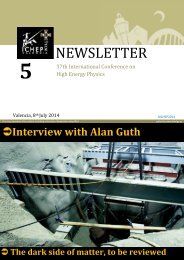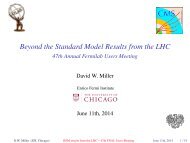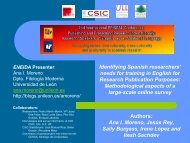PW_mar13_sample_issue
PW_mar13_sample_issue
PW_mar13_sample_issue
You also want an ePaper? Increase the reach of your titles
YUMPU automatically turns print PDFs into web optimized ePapers that Google loves.
Frontiers<br />
In brief<br />
Diamond downsizes MRI and NMR<br />
Magnetic-resonance-imaging technology<br />
has been shrunk to the nanoscale by two<br />
independent teams of researchers in Germany<br />
and the US, so that molecular <strong>sample</strong>s just a<br />
few cubic nanometres in volume can now be<br />
detected and imaged at room temperature. Both<br />
groups used nitrogen-vacancy (NV) defects in<br />
diamonds as magnetic-field sensors to probe<br />
such minute <strong>sample</strong>s. NV defects occur when<br />
two neighbouring carbon atoms in diamonds<br />
are replaced by a nitrogen atom and an empty<br />
lattice site. NV sites are capable of detecting the<br />
very weak oscillatory magnetic fields that come<br />
from the spins of protons in a <strong>sample</strong>. Apart<br />
from being able to resolve a single atom at room<br />
temperature, the technique could be used as a<br />
polarizing agent for traditional NMR and could<br />
also help the nanotechnology community image<br />
tiny devices (Science 339 557; 339 561).<br />
‘Just add water’ for hydrogen on demand<br />
Silicon nanoparticles could be used to produce<br />
hydrogen almost instantly, as they react with<br />
water, according to researchers in the US. The<br />
reaction does not require any heat, light or<br />
electricity and the hydrogen generated could<br />
be used to power small fuel cells. In essence,<br />
the technique recovers some of the energy that<br />
goes into refining the silicon and producing the<br />
nanoparticles in the first place. Thanks to their<br />
high surface-to-volume ratio, the nanoparticles<br />
should naturally generate hydrogen much more<br />
quickly than bulk silicon. The advantage of<br />
silicon is that it is abundant on our planet, has<br />
a high energy density and does not release any<br />
carbon dioxide when it reacts with water. The<br />
researchers have already successfully tested<br />
their technique in a small fuel cell that they used<br />
to power a fan (Nano Lett. 10.1021/nl304680w).<br />
Stored photons interact in atom cloud<br />
Physicists in the UK have come up with a<br />
new way of storing a handful of photons in an<br />
ultracold atomic gas, in which strong interactions<br />
between neighbouring photons can be switched<br />
on and off using microwaves. Once stored, the<br />
photons can be made to interact strongly, before<br />
being released again. An important feature of<br />
the technique is that it uses microwaves, which<br />
are also used to control some types of stationary<br />
qubit. The team believes that the technique<br />
could be used to create optical logic gates in<br />
which single photons could be processed one at<br />
a time. The method could also prove useful for<br />
connecting quantum-computing devices based<br />
on different technologies (arXiv:1207.6007v3).<br />
Read these articles in full and sign up for free<br />
e-mail news alerts at physicsworld.com<br />
4<br />
A new method to produce indistinguishable<br />
and coherent electrons has been developed<br />
by scientists in France. They have<br />
used it to make a small, electron-emitting<br />
chip that can produce two single electrons<br />
emitted from different sources that are in<br />
the same quantum state. This is a key step<br />
in developing electron-based quantum-<br />
information-processing techniques.<br />
Electrons are fermions and so must obey<br />
Pauli’s exclusion principle, which prevents<br />
identical fermions from occupying the<br />
same state, and so leads to anticorrelations<br />
or “antibunching”. Erwann Bocquillon and<br />
Gwendal Fève at the Ecole Normale Supérieure<br />
in Paris and Lyon, along with colleagues<br />
from the Laboratory for Photonics<br />
and Nanostructures, Paris, wanted to see if<br />
indistinguishable electrons could be generated<br />
by independent sources. But as there<br />
are many electrons in any system, and they<br />
all interfere with each other and with the<br />
environment, making coherent electron<br />
beams is difficult.<br />
The researchers’ electron-emitting chip<br />
physicsworld.com<br />
Emitting indistinguishable electrons<br />
emitter 1<br />
beam splitter<br />
Neutrons on demand<br />
emitter 2<br />
Coherent beams A chip off the semiconductor dot.<br />
A new compact high-flux source of energetic<br />
neutrons has been built by physicists<br />
in Germany and the US. The laser-based<br />
device has the potential to be cheaper and<br />
more convenient than the large neutron<br />
facilities currently used by scientists and<br />
could be housed in university laboratories.<br />
Built by Markus Roth of the Technische<br />
Universität Darmstadt and colleagues at<br />
Los Alamos and Sandia national laboratories,<br />
the device builds on previous research<br />
carried out at Los Alamos in 2006, which<br />
used computer simulations to show that<br />
an intense laser beam can penetrate a thin<br />
solid target, producing the necessary highenergy<br />
neutron flux. Roth’s team directed<br />
extremely powerful and well-defined<br />
pulses from the Los Alamos TRIDENT<br />
laser onto a 400 nm-thick plastic target<br />
D Darson<br />
(pictured) was built using a “very clean”<br />
micron-sized bulk-semiconductor <strong>sample</strong><br />
in which the electrons propagate in straight<br />
lines for several microns in 2D before being<br />
scattered, limiting their interactions. A<br />
strong magnetic field is then used to further<br />
restrict the movement of the electrons<br />
to only 1D so that single electrons may be<br />
guided to each of the emitters. By applying a<br />
voltage pulse to metallic electrodes deposited<br />
on top of the emitters, the researchers<br />
trigger the emission of a single electron to<br />
an electronic beamsplitter that is made up<br />
of two input and two output arms. Fève says<br />
that their <strong>sample</strong> is capable of emitting billions<br />
of single electrons per second – one<br />
electron per nanosecond.<br />
“The two sources are perfectly synchronized<br />
such that both particles arrive<br />
simultaneously on the splitter and perfect<br />
antibunching occurs, meaning the two<br />
electrons always exit in different outputs,”<br />
explains Fève. That means that the two<br />
electrons, generated by the two identical,<br />
synchronized emitters would arrive simultaneously<br />
at the two input arms of the splitter<br />
and would always emerge in two distinct<br />
outputs, obeying Pauli’s principle.<br />
But Fève is quick to point out that while<br />
the team did achieve a high degree of<br />
indistinguishability, some minimal environmental<br />
interaction did occur. The<br />
team is looking at making its <strong>sample</strong> even<br />
smaller so that the electrons travel even<br />
shorter distances, while keeping in mind<br />
the effects of temperature at such sizes<br />
(Science 10.1126/science.1232572).<br />
doped with deuterium atoms that was positioned<br />
5 mm in front of a secondary target<br />
made from beryllium.<br />
Even though the pulses delivered less<br />
than a quarter of the energy employed in<br />
previous experiments, they produced neutrons<br />
that were nearly 10 times as energetic<br />
– up to 150 MeV – and nearly 10 times as<br />
numerous. The group took the first radiographs<br />
using this beam by placing a series of<br />
tungsten, steel and plastic objects between<br />
the neutron source and a scintillating fibre<br />
array that was linked to a CCD camera.<br />
Roth says that although his group’s device<br />
produces fewer neutrons than reactors or<br />
accelerators do, it packs the neutrons into<br />
pulses – each lasting just 10 –8 s. This makes<br />
it suitable for applications that need high<br />
temporal resolution. Roth claims that, once<br />
commercialized, the entire device would fit<br />
on a lab bench and that only the target would<br />
need shielding (Phys. Rev. Lett. 110 044802).<br />
Physics World March 2013








